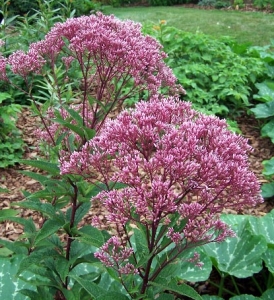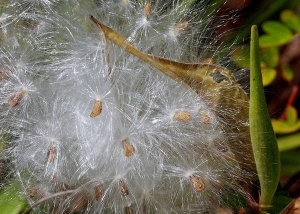A Beginner’s Guide to Butterfly Gardens

Common Buckeye, frequent visitor to Fairfax yards
Food, water, and shelter — these are the basic elements needed to attract wildlife. Butterflies respond to them no differently than other living things. If you are looking to start a butterfly garden in your own yard, you will need to pay attention to the butterflies’ requirements.
Food
Attracting the adult butterfly to sip nectar from your garden is easy; they are drawn to practically any flower and will take nectar from it. The best nectar-sipping flowers for butterflies are structured with a number of short flower stalks that are often flat-topped with convex flower heads. Examples include zinnias, lantana, milkweed, clover, yarrow, phlox, marigolds, Joe Pye weed and herbs in flower, such as dill, parsley and chives. However, if you would like to keep the adult butterfly around the garden a bit longer, consider planting host plants.

Joe Pye weed (Eupatorium purpureum)
Host plants are the food plants for the butterfly larvae. The adult female butterfly will lay eggs generally on the underside of the leaves of a host plant. Within a few days, the larvae will hatch and begin eating the host plant. Host plants can be flowers, weeds, herbs, shrubs and trees. Many folks are familiar with the migration pattern of the monarch butterfly and understand that milkweed is the host plant for the monarch larvae. But few people know that the simple ground violet that many lawn enthusiasts consider a weed is the host plant for the great spangled fritillary. Dill and parsley can often be seen with black swallowtail larvae, munching them down to stubs. Milkweed, dill and parsley are examples of plants that can serve as both nectar and host plants for the butterfly kingdom. The additional joy that you can receive from offering host plants within your garden is that you will often see the next generation hatch within your yard, and before you know it, your yard has become a butterfly magnet.

black swallowtail larva on dill weed
Synthetic pesticides in the garden will dampen your butterfly garden results. Pesticides such as carbaryl (e.g., the product named Sevin) will kill butterfly larvae along with the insect larvae you don’t want eating your tomato or dill plants. Based on my observations of neighboring yards with differing land-management practices, I witness a distinct lack of butterfly life in yards where synthetic pesticides are actively used. The difference is amazing.
Water
An additional feature that is nice to provide is a puddling spot. Many butterflies bask in the sun and need a very shallow offering of water. To create one, select a shallow container such as a water catcher or dish of a planter; fill it with sand, and arrange a few rocks for perches. Add water and place in a sunny location. Set the dish into the ground so that it is at ground level. This will help reduce some of the water evaporation.
Shelter
Trees and shrubs offer protection from strong winds, rains, and — depending on the butterfly — may offer overwintering sites for your new neighbors. While decorative butterfly houses may be attractive to you, realize that the butterflies may not agree. Just because it is called a butterfly house, does not make it so. Nature provided homes for its critters long before retailers got into the act.
Location
Sunny locations are the best for your butterfly garden and are likely to attract a larger population and diversity of butterflies. If you are challenged with shade, do not give up. As mentioned earlier, the common violet is a host plant, and it grows in a fair amount of shade. It may not bring in large swallowtails to take nectar from its flower, but it can help you gain a better understanding of the large diversity of native butterflies in your area and what they need to survive. The next time you are walking in your spring garden, get on your knees to smell the violets, and see whether their leaves are ragged with holes. Take a look later that evening, and you may find the small larvae of a native fritillary in your yard.
Decisions
Avoiding the use of synthetic pesticides is one of the decisions you must make, if you wish to establish a thriving butterfly garden. Another factor to weigh is what your butterfly garden will look like over the seasons. You should consider having continuous blooms from your nectar plants to provide an ongoing supply of food for your butterflies. Continuous blooming in your garden adds to your pleasure and the diets of the adult butterflies. Keep in mind that butterfly larvae will eat the host plants. In fact, they will eat dill and parsley down to stumps. Violets and other native host plants may have leaves with holes or sections missing. You don’t get something (butterflies) for nothing (food).
Another concern for some gardeners is that seedpods of milkweed will burst, sending their seeds to float through the air. Summer rains can often make the silky filaments clump and look like there are pieces of wet toilet paper hanging around your yard. In other words, butterfly gardens can be a bit messy-looking at times, but the butterflies, bees and other pollinators and wildlife LOVE this look. It is what they need and want in a home.

milkweed (Asclepias tuberosa) seed pods
In summary, if you want to attract butterflies to your space:
- Plant both nectar and host plants
- Plant a variety of flowering plants to ensure continuous bloom over the growing season, which will support a variety of butterflies and encourage offspring
- Offer a puddling spot in a sunny location
- Provide some protective shelter
- Eliminate the use of synthetic pesticides in your yard
Resources
• For the Birds, Butterflies & Hummingbirds: Creating Inviting Habitats, Mary Free, Virginia Cooperative
Extension
• Butterflies and Moths of North America
• Butterflies Occurring in the DC Area, Lep Log Blog
• The Butterfly Society of Virginia